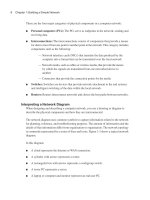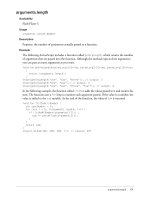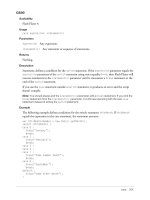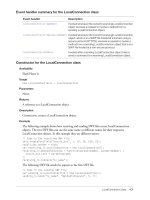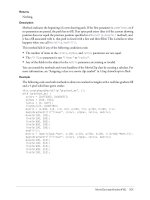Tài liệu Flash: ActionScript Language Reference- P2 pptx
Bạn đang xem bản rút gọn của tài liệu. Xem và tải ngay bản đầy đủ của tài liệu tại đây (342.51 KB, 100 trang )
arguments.length 101
arguments.length
Availability
Flash Player 5.
Usage
arguments.length:Number
Description
Property; the number of parameters actually passed to a function.
Example
The following ActionScript includes a function called
getArgLength
, which returns the number
of arguments that are passed into the function. Although the method expects three arguments,
you can pass as many arguments as you want.
function getArgLength(param_arg1:String, param_arg2:String, param_arg3:String)
{
return (arguments.length);
}
trace(getArgLength("one", "two", "three")); // output: 3
trace(getArgLength("one", "two")); // output: 2
trace(getArgLength("one", "two", "three", "four")); // output: 4
In the following example, the function called
listSum
adds the values passed to it and returns the
sum. The function uses a
for
loop to examine each argument passed. If the value is a number, the
value is added to the
sum
variable. At the end of the function, the value of
sum
is returned.
function listSum():Number {
var sum:Number = 0;
for (var i = 0; i<arguments.length; i++) {
if (!isNaN(Number(arguments[i]))) {
sum += parseFloat(arguments[i]);
}
}
return sum;
}
trace(listSum(100, 200, 300, 7)); // output: 607
102 Chapter 2: ActionScript Language Reference
Array()
Availability
Flash Player 6.
Usage
Array() : Array
Array(numElements:Number) : Array
Array( [element0:Object [, element1 , element2,...elementN ] ]) : Array
Parameters
element
One or more elements to place in the array.
Returns
An array.
Description
Conversion function; creates a new, empty array or converts specified elements to an array. Using
this function is similar to creating an array with the Array constructor (see “Constructor for the
Array class” on page 104).
Example
Usage 1: The following example adds items to an array by using the array’s index and then by
using the Array class’s
push
method:
var myArray:Array = Array();
myArray.push(12);
trace(myArray); //traces 12
myArray[4] = 7;
trace(myArray); //traces 12,undefined,undefined,undefined,7
Usage 2: The following example creates an array of length 4 but with no elements defined:
var myArray:Array = Array(4);
trace(myArray.length); // traces 4
trace(myArray); // traces undefined,undefined,undefined,undefined
Usage 3: The following example creates an array with three defined elements:
var myArray:Array = Array(["firstElement", "secondElement", "thirdElement"]);
trace (myArray); // traces firstElement,secondElement,thirdElement
Note: Unlike the Array class constructor, the Array() function does not use the keyword new.
See also
Array class
CHAPTER 2
ActionScript Language Reference
Array class 103
Array class
Availability
Flash Player 5 (became a native object in Flash Player 6, which improved
performance significantly).
Description
The Array class lets you access and manipulate arrays. An array is an object whose properties are
identified by a number representing their position in the array. This number is referred to as the
index. All arrays are zero-based, which means that the first element in the array is [0], the second
element is [1], and so on. To create an Array object, you use the constructor
new Array()
. To
access the elements of an array, you use the array access (
[]
) operator.
In the following example,
my_array
contains four months of the year:
var my_array:Array = new Array();
my_array[0] = "January";
my_array[1] = "February";
my_array[2] = "March";
my_array[3] = "April";
Method summary for the Array class
Property summary for the Array class
Method Description
Array.concat()
Concatenates the parameters and returns them as a new array.
Array.join()
Joins all elements of an array into a string.
Array.pop()
Removes the last element of an array and returns its value.
Array.push()
Adds one or more elements to the end of an array and returns the array’s new
length.
Array.reverse()
Reverses the direction of an array.
Array.shift()
Removes the first element from an array and returns its value.
Array.slice()
Extracts a section of an array and returns it as a new array.
Array.sort()
Sorts an array in place.
Array.sortOn()
Sorts an array according to a field in the array.
Array.splice()
Adds and removes elements from an array.
Array.toString()
Returns a string value representing the elements in the Array object.
Array.unshift()
Adds one or more elements to the beginning of an array and returns the array’s
new length.
Property Description
Array.length
A non-negative integer specifying the number of elements in the array.
CHAPTER 2
ActionScript Language Reference
104 Chapter 2: ActionScript Language Reference
Constructor for the Array class
Availability
Flash Player 5.
Usage
new Array() : Array
new Array(length:Number) : Array
new Array(element0, element1, element2,...elementN) : Array
Parameters
length
An integer that specifies the number of elements in the array.
element0...elementN
A list of two or more arbitrary values. The values can be of type
Boolean, Number, String, Object, or Array. The first element in an array always has an index or
position of 0.
Note: If only a single numeric parameter is passed to the Array constructor, it is assumed to be
length and it is converted to an integer using the Integer() function.
Returns
A reference to an Array object.
Description
Constructor; lets you create an array. You can use the constructor to create different types of
arrays: an empty array, an array with a specific length but whose elements have undefined values,
or an array whose elements have specific values.
Usage 1: If you don’t specify any parameters, an array with a length of 0 is created.
Usage 2: If you specify only a length, an array is created with
length
number of elements. Each
element’s value is set to
undefined
.
Usage 3: If you use the
element
parameters to specify values, an array is created with
specific values.
Example
Usage 1: The following example creates a new Array object with an initial length of 0:
var my_array:Array = new Array();
trace(my_array.length); // traces 0
Usage 2: The following example creates a new Array object with an initial length of 4:
var my_array:Array = new Array(4);
trace(my_array.length); // returns 4
trace(my_array[0]); // returns undefined
if (my_array[0] == undefined) { // no quotation marks around undefined
trace("undefined is a special value, not a string");
} // traces: undefined is a special value, not a string
Array class 105
Usage 3: The following example creates the new Array object
go_gos_array
with an initial
length of 5:
var go_gos_array:Array = new Array("Belinda", "Gina", "Kathy", "Charlotte",
"Jane");
trace(go_gos_array.length); // returns 5
trace(go_gos_array.join(", ")); // displays elements
The initial elements of the
go_gos_array
array are identified, as shown in the following example:
go_gos_array[0] = "Belinda";
go_gos_array[1] = "Gina";
go_gos_array[2] = "Kathy";
go_gos_array[3] = "Charlotte";
go_gos_array[4] = "Jane";
The following code adds a sixth element to the
go_gos_array
array and changes the second
element:
go_gos_array[5] = "Donna";
go_gos_array[1] = "Nina"
trace(go_gos_array.join(" + "));
// returns Belinda + Nina + Kathy + Charlotte + Jane + Donna
See also
Array.length, [] (array access)
106 Chapter 2: ActionScript Language Reference
Array.concat()
Availability
Flash Player 5.
Usage
my_array.concat( [ value0:Object, value1,...valueN ]) : Array
Parameters
value0,...valueN
Numbers, elements, or strings to be concatenated in a new array. If you
don’t pass any values, a duplicate of
my_array
is created.
Returns
An array.
Description
Method; concatenates the elements specified in the parameters with the elements in
my_array
,
and creates a new array. If the
value
parameters specify an array, the elements of that array are
concatenated, rather than the array itself. The array
my_array
is left unchanged.
Example
The following code concatenates two arrays:
var alpha_array:Array = new Array("a","b","c");
var numeric_array:Array = new Array(1,2,3);
var alphaNumeric_array:Array =alpha_array.concat(numeric_array);
trace(alphaNumeric_array);
// creates array [a,b,c,1,2,3]
The following code concatenates three arrays:
var num1_array:Array = [1,3,5];
var num2_array:Array = [2,4,6];
var num3_array:Array = [7,8,9];
var nums_array:Array=num1_array.concat(num2_array,num3_array)
trace(nums_array);
// creates array [1,3,5,2,4,6,7,8,9]
Nested arrays are not flattened in the same way as normal arrays. The elements in a nested array
are not broken into separate elements in array
x_array
, as shown in the following example:
var a_array:Array = new Array ("a","b","c");
// 2 and 3 are elements in a nested array
var n_array:Array = new Array(1, [2, 3], 4);
var x_array:Array = a_array.concat(n_array);
trace(x_array[0]); // a
trace(x_array[1]); // b
trace(x_array[2]); // c
trace(x_array[3]); // 1
trace(x_array[4]); // 2, 3
trace(x_array[5]); // 4
Array.join() 107
Array.join()
Availability
Flash Player 5.
Usage
my_array.join([separator:String]) : String
Parameters
separator
A character or string that separates array elements in the returned string. If you omit
this parameter, a comma (,) is used as the default separator.
Returns
A string.
Description
Method; converts the elements in an array to strings, inserts the specified separator between the
elements, concatenates them, and returns the resulting string. A nested array is always separated
by a comma (,), not by the separator passed to the
join()
method.
Example
The following example creates an array with three elements: Earth, Moon, and Sun. It then joins
the array three times—first using the default separator (a comma [,] and a space), then using a
dash (-), and then using a plus sign (+).
var a_array:Array = new Array("Earth","Moon","Sun")
trace(a_array.join());
// displays Earth,Moon,Sun
trace(a_array.join(" - "));
// displays Earth - Moon - Sun
trace(a_array.join(" + "));
// displays Earth + Moon + Sun
The following example creates a nested array containing two arrays. The first array has three
elements: Europa, Io, and Callisto. The second array has two elements: Titan and Rhea. It joins
the array using a plus sign (+), but the elements within each nested array remain separated by a
comma (,).
var a_nested_array:Array = new Array(["Europa", "Io", "Callisto"], ["Titan",
"Rhea"]);
trace(a_nested_array.join(" + "));
// returns Europa,Io,Callisto + Titan,Rhea
See Also
String.split()
108 Chapter 2: ActionScript Language Reference
Array.length
Availability
Flash Player 5.
Usage
my_array.length:Number
Description
Property; a non-negative integer specifying the number of elements in the array. This property is
automatically updated when new elements are added to the array. When you assign a value to an
array element (for example,
my_array[index] = value
), if
index
is a number, and
index+1
is
greater than the
length
property, the
length
property is updated to
index+1
.
Note: If you assign a value to the length property that is shorter than the existing length, the array will
be truncated.
Example
The following code explains how the
length
property is updated:
var my_array:Array = new Array();
trace(my_array.length); // initial length is 0
my_array[0] = 'a';
trace(my_array.length); // my_array.length is updated to 1
my_array[1] = 'b';
trace(my_array.length); // my_array.length is updated to 2
my_array[9] = 'c';
trace(my_array.length); // my_array.length is updated to 10
trace(my_array);
// displays:
// a,b,undefined,undefined,undefined,undefined,undefined,undefined,undefined,c
// if the length property is now set to 5, the array will be truncated
my_array.length = 5;
trace(my_array.length); // my_array.length is updated to 5
trace(my_array); // outputs: a,b,undefined,undefined,undefined
Array.pop() 109
Array.pop()
Availability
Flash Player 5.
Usage
my_array.pop() : Object
Parameters
None.
Returns
The value of the last element in the specified array.
Description
Method; removes the last element from an array and returns the value of that element.
Example
The following code creates the
myPets_array
array containing four elements, and then removes
its last element:
var myPets_array:Array = new Array("cat", "dog", "bird", "fish");
var popped:String = myPets_array.pop();
trace(popped); // displays fish
trace(myPets_array); // displays cat,dog,bird
See Also
Array.push(), Array.shift(), Array.unshift()
110 Chapter 2: ActionScript Language Reference
Array.push()
Availability
Flash Player 5.
Usage
my_array.push(value,...) : Number
Parameters
value
One or more values to append to the array.
Returns
An integer representing the length of the new array.
Description
Method; adds one or more elements to the end of an array and returns the array’s new length.
Example
The following example creates the array
myPets_array
with two elements,
cat
and
dog
. The
second line adds two elements to the array. Because the
push()
method returns the new length of
the array, the
trace()
statement in the last line sends the new length of
myPets_array
(
4
) to the
Output panel.
var myPets_array:Array = new Array("cat", "dog");
var pushed:Number = myPets_array.push("bird", "fish");
trace(pushed); // displays 4
See Also
Array.pop(), Array.shift(), Array.unshift()
Array.reverse() 111
Array.reverse()
Availability
Flash Player 5.
Usage
my_array.reverse() : Void
Parameters
None.
Returns
Nothing.
Description
Method; reverses the array in place.
Example
The following example uses this method to reverse the array
numbers_array
:
var numbers_array:Array = new Array(1, 2, 3, 4, 5, 6);
trace(numbers_array); // displays 1,2,3,4,5,6
numbers_array.reverse();
trace(numbers_array); // displays 6,5,4,3,2,1
112 Chapter 2: ActionScript Language Reference
Array.shift()
Availability
Flash Player 5.
Usage
my_array.shift() : Object
Parameters
None.
Returns
The first element in an array.
Description
Method; removes the first element from an array and returns that element.
Example
The following code creates the array
myPets_array
and then removes the first element from the
array and assigns it to the variable
shifted
:
var myPets_array:Array = new Array("cat", "dog", "bird", "fish");
var shifted:String = myPets_array.shift();
trace(shifted); // displays "cat"
trace(myPets_array); // displays dog,bird,fish
See also
Array.pop(), Array.push(), Array.unshift()
Array.slice() 113
Array.slice()
Availability
Flash Player 5.
Usage
my_array.slice( [ start:Number [ , end:Number ] ] ) : Array
Parameters
start
A number specifying the index of the starting point for the slice. If
start
is a negative
number, the starting point begins at the end of the array, where -1 is the last element.
end
A number specifying the index of the ending point for the slice. If you omit this parameter,
the slice includes all elements from the starting point to the end of the array. If
end
is a negative
number, the ending point is specified from the end of the array, where -1 is the last element.
Returns
An array.
Description
Method; returns a new array that consists of a range of elements from the original array, without
modifying the original array. The returned array includes the
start
element and all elements up
to, but not including, the
end
element.
If you don’t pass any parameters, a duplicate of
my_array
is created.
Example
The following example creates an array of five pets and uses
slice()
to populate a new array
comprising only four-legged pets:
var myPets_array:Array = new Array("cat", "dog", "fish", "canary", "parrot");
var myFourLeggedPets_array:Array = new Array();
var myFourLeggedPets_array = myPets_array.slice(0, 2);
trace(myFourLeggedPets_array); // returns cat,dog
trace(myPets_array); // returns cat,dog,fish,canary,parrot
The following example creates an array of five pets, and then uses
slice()
with a negative
start
parameter to copy the last two elements from the array:
var myPets_array:Array = new Array("cat", "dog", "fish", "canary", "parrot");
var myFlyingPets_array:Array = myPets_array.slice(-2);
trace(myFlyingPets_array); // traces canary,parrot
The following example creates an array of five pets and uses
slice()
with a negative
end
parameter to copy the middle element from the array:
var myPets_array:Array = new Array("cat", "dog", "fish", "canary", "parrot");
var myAquaticPets_array:Array = myPets_array.slice(2,-2);
trace(myAquaticPets_array); // returns fish
114 Chapter 2: ActionScript Language Reference
Array.sort()
Availability
Flash Player 5; additional capabilities added in Flash Player 7.
Usage
my_array.sort() : Array
my_array.sort(compareFunction:Function) : Array
my_array.sort(option:Number | option |... ) : Array
my_array.sort(compareFunction:Function, option:Number | option |... ) : Array
Parameters
compareFunction
A comparison function used to determine the sorting order of elements in
an array. Given the elements A and B, the result of
compareFunction
can have one of the
following three values:
•
-1, if A should appear before B in the sorted sequence
•
0, if A equals B
•
1, if A should appear after B in the sorted sequence
option
One or more numbers or names of defined constants, separated by the
|
(bitwise OR)
operator, that change the behavior of the sort from the default. The following values are
acceptable for
option
:
•
1 or
Array.CASEINSENSITIVE
•
2 or
Array.DESCENDING
•
4 or
Array.UNIQUESORT
•
8 or
Array.RETURNINDEXEDARRAY
•
16 or
Array.NUMERIC
For information on this parameter, see Array.sortOn().
Note: Array.sort() is defined in ECMA-262, but the array sorting options introduced in Flash
Player 7 are Flash-specific extensions to the ECMA-262 specification.
Returns
The return value depends on whether you pass any parameters, as described in the following list:
•
If you specify a value of 4 or
Array.UNIQUESORT
for
option
and two or more elements being
sorted have identical sort fields, Flash returns a value of 0 and does not modify the array.
•
If you specify a value of 8 or
Array.RETURNINDEXEDARRAY
for
option
, Flash returns an array
that reflects the results of the sort and does not modify the array.
•
Otherwise, Flash returns nothing and modifies the array to reflect the sort order.
Description
Method; sorts the elements in an array. Flash sorts according to Unicode values. (ASCII is a subset
of Unicode.)
Array.sort() 115
By default,
Array
.
sort()
works as described in the following list:
•
Sorting is case-sensitive (Z precedes a).
•
Sorting is ascending (a precedes b).
•
The array is modified to reflect the sort order; multiple elements that have identical sort fields
are placed consecutively in the sorted array in no particular order.
•
Numeric fields are sorted as if they were strings, so 100 precedes 99, because “1” is a lower
string value than “9”.
If you want to sort in another way, create a function to do the sorting and pass its name as the
compareFunction
parameter. You might do this, for example, if you want to sort alphabetically
by last name, ascending, and then by ZIP code, descending.
If you want to specify one or more fields on which to sort, using either the default sort or the
options
parameter, use Array.sortOn().
Example
Usage 1: The following example shows the use of
Array.sort()
with and without a value passed
for
option
:
var fruits_array:Array = new Array("oranges", "apples", "strawberries",
"pineapples", "cherries");
trace(fruits_array); // displays
oranges,apples,strawberries,pineapples,cherries
fruits_array.sort();
trace(fruits_array); // displays
apples,cherries,oranges,pineapples,strawberries
fruits_array.sort(Array.DESCENDING);
trace(fruits_array); // displays
strawberries,pineapples,oranges,cherries,apples
Usage 2: The following example uses
Array.sort()
with a compare function:
var passwords_array:Array = new Array("mom:glam", "ana:ring", "jay:mag",
"anne:home", "regina:silly");
function order(a, b):Number {
//Entries to be sorted are in form name:password
//Sort using only the name part of the entry as a key.
var name1:String = a.split(":")[0];
var name2:String = b.split(":")[0];
if (name1<name2) {
return -1;
} else if (name1>name2) {
return 1;
} else {
return 0;
}
}
trace("Unsorted:");
//displays Unsorted:
trace(passwords_array);
//displays mom:glam,ana:ring,jay:mag,anne:home,regina:silly
passwords_array.sort(order);
116 Chapter 2: ActionScript Language Reference
trace("Sorted:");
//displays Sorted:
trace(passwords_array);
//displays ana:ring,anne:home,jay:mag,mom:glam,regina:silly
See also
| (bitwise OR)
, Array.sortOn()
Array.sortOn() 117
Array.sortOn()
Availability
Flash Player 6; additional capabilities added in Flash Player 7.
Usage
my_array.sortOn("fieldName":String ) : Array
my_array.sortOn("fieldName":String, option:Number | option |... ) : Array
my_array.sortOn( [ "fieldName" , "fieldName" , ... ]:Array) : Array
my_array.sortOn( [ "fieldName" , "fieldName" , ... ]:Array , option:Number |
option |... ) : Array
Note: Where brackets ([]) are shown, you must include them in the code; that is, the brackets don’t
represent optional parameters.
Parameters
fieldName
A string that identifies a field (in an element of the Array) to be used as the
sort value.
option
One or more numbers or names of defined constants, separated by the
|
(bitwise OR)
operator, that change the behavior of the sort from the default. The following values are
acceptable for
option
:
•
1 or
Array.CASEINSENSITIVE
•
2 or
Array.DESCENDING
•
4 or
Array.UNIQUESORT
•
8 or
Array.RETURNINDEXEDARRAY
•
16 or
Array.NUMERIC
For more information about each option, see “Description” on page 117.
Returns
The return value depends on whether you pass any parameters, as described in the following list:
•
If you specify a value of 4 or
Array.UNIQUESORT
for
option
, and two or more elements being
sorted have identical sort fields, Flash returns a value of 0 and does not modify the array.
•
If you specify a value of 8 or
Array.RETURNINDEXEDARRAY
for
option
, Flash returns an Array
that reflects the results of the sort and does not modify the array.
•
Otherwise, Flash returns nothing and modifies the array to reflect the sort order.
Description
Method; sorts the elements in an array according to one or more fields in the array. If you pass
multiple
fieldName
parameters, the first field represents the primary sort field, the second
represents the next sort field, and so on. Flash sorts according to Unicode values. (ASCII is a
subset of Unicode.) If either of the elements being compared does not contain the field specified
in the
fieldName
parameter, the field is assumed to be
undefined
, and the elements are placed
consecutively in the sorted array in no particular order.
118 Chapter 2: ActionScript Language Reference
By default,
Array
.
sortOn()
works as described in the following list:
•
Sorting is case-sensitive (Z precedes a).
•
Sorting is ascending (a precedes b).
•
The array is modified to reflect the sort order; multiple elements that have identical sort fields
are placed consecutively in the sorted array in no particular order.
•
Numeric fields are sorted as if they were strings, so 100 precedes 99, because “1” is a lower
string value than “9”.
You can use the
option
flags to override these defaults. The following examples use different
forms of the
option
flag for illustration purposes. If you want to sort a simple array (for example,
an array with only one field), or if you want to specify a sort order that the
options
parameter
doesn’t support, use Array.sort().
To pass multiple flags in numeric format, separate them with the bitwise OR (
|
) operator or add
the values of the flags together. The following code shows three ways to specify a numeric
descending sort:
my_array.sortOn(someFieldName, 2 | 16);
my_array.sortOn(someFieldName, 18);
my_array.sortOn(someFieldName, Array.DESCENDING | Array.NUMERIC);
Code hinting (see “Using code hints” in Using ActionScript in Flash) is enabled if you use the
string form of the flag (for example,
DESCENDING
) rather than the numeric form (2).
Consider the following array:
var my_array:Array = new Array();
my_array.push({password: "Bob", age:29});
my_array.push({password: "abcd", age:3});
my_array.push({password: "barb", age:35});
my_array.push({password: "catchy", age:4});
Performing a default sort on the password field produces the following results:
my_array.sortOn("password");
// Bob
// abcd
// barb
// catchy
Performing a case-insensitive sort on the password field produces the following results:
my_array.sortOn("password", Array.CASEINSENSITIVE);
// abcd
// barb
// Bob
// catchy
Performing a case-insensitive, descending sort on the password field produces the following
results:
my_array.sortOn("password", 1|2);
// catchy
// Bob
Array.sortOn() 119
// barb
// abcd
Performing a default sort on the age field produces the following results:
my_array.sortOn("age");
// 29
// 3
// 35
// 4
Performing a numeric sort on the age field produces the following results:
my_array.sortOn("age", 16);
// 3
// 4
// 29
// 35
Performing a descending numeric sort on the age field produces the following results:
my_array.sortOn("age", 18);
// 35
// 29
// 4
// 3
Performing a sort changes the elements in the array produces the following results:
// Before sorting
// my_array[0].age = 29;
// my_array[1].age = 3;
// my_array[2].age = 35;
// my_array[3].age = 4;
// After any sort that doesn’t pass a value of 8 for option
my_array.sortOn("age", Array.NUMERIC);
// my_array[0].age = 3;
// my_array[1].age = 4;
// my_array[2].age = 29;
// my_array[3].age = 35;
Performing a sort that returns an index array doesn’t change the elements in the array, as shown in
the following example:
// Before sorting
// my_array[0].age = 29;
// my_array[1].age = 3;
// my_array[2].age = 35;
// my_array[3].age = 4;
// After a sort that returns an array containing index values
// Note that the original array is unchanged.
// You can then use the returned array to display sorted information
// without modifying the original array.
var indexArray:Array = my_array.sortOn("age", Array.RETURNINDEXEDARRAY);
// my_array[0].age = 29;
// my_array[1].age = 3;
120 Chapter 2: ActionScript Language Reference
// my_array[2].age = 35;
// my_array[3].age = 4;
Example
The following example creates a new array and sorts it according to the fields
name
and
city
: The
first sort uses
name
as the first sort value and
city
as the second. The second sort uses
city
as the
first sort value and
name
as the second.
var rec_array:Array = new Array();
rec_array.push( { name: "john", city: "omaha", zip: 68144 } );
rec_array.push( { name: "john", city: "kansas city", zip: 72345 } );
rec_array.push( { name: "bob", city: "omaha", zip: 94010 } );
for(i=0; i<rec_array.length; i++) {
trace(rec_array[i].name + ", " + rec_array[i].city);
}
// results:
// john, omaha
// john, kansas city
// bob, omaha
rec_array.sortOn( [ "name", "city" ]);
for(i=0; i<rec_array.length; i++) {
trace(rec_array[i].name + ", " + rec_array[i].city);
}
// results:
// bob, omaha
// john, kansas city
// john, omaha
rec_array.sortOn( ["city", "name" ]);
for(i=0; i<rec_array.length; i++) {
trace(rec_array[i].name + ", " + rec_array[i].city);
}
// results:
// john, kansas city
// bob, omaha
// john, omaha
See also
| (bitwise OR)
, Array.sort()
Array.splice() 121
Array.splice()
Availability
Flash Player 5.
Usage
my_array.splice(start:Number, deleteCount:Number [, value0:Object,
value1...valueN]) : Array
Parameters
start
An integer that specifies the index of the element in the array where the insertion or
deletion begins.
deleteCount
An integer that specifies the number of elements to be deleted. This number
includes the element specified in the
start
parameter. If no value is specified for
deleteCount
,
the method deletes all the values from the
start
element to the last element in the array. If the
value is 0, no elements are deleted.
value
An optional parameter that specifies the values to insert into the array at the insertion
point specified in the
start
parameter.
Returns
The elements that were removed from the array.
Description
Method; adds and removes elements from an array. This method modifies the array without
making a copy.
Example
The following example creates an array and splices it using element index 1 for the
start
parameter. This removes all elements from the array starting with the second element, leaving
only the element at index 0 in the original array:
var myPets_array:Array = new Array("cat", "dog", "bird", "fish");
trace( myPets_array.splice(1) ); // dog,bird,fish
trace( myPets_array ); // cat
The following example creates an array and splices it using element index 1 for the
start
parameter and the number 2 for the
deleteCount
parameter. This removes two elements from
the array, starting with the second element, leaving the first and last elements in the original array:
var myFlowers_array:Array = new Array("roses", "tulips", "lilies", "orchids");
trace( myFlowers_array.splice(1,2 ) ); // tulips,lilies
trace( myFlowers_array ); // roses,orchids
122 Chapter 2: ActionScript Language Reference
The following example creates an array and splices it using element index 1 for the
start
parameter, the number 0 for the
deleteCount
parameter, and the string
chair
for the
value
parameter. This does not remove anything from the original array, and adds the string
chair
at
index 1:
var myFurniture_array:Array = new Array("couch", "bed", "desk", "lamp");
trace( myFurniture_array.splice(1,0, "chair" ) ); // displays empty array
trace( myFurniture_array ); // displays couch,chair,bed,desk,lamp
Array.toString() 123
Array.toString()
Availability
Flash Player 5.
Usage
my_array.toString() : String
Parameters
None.
Returns
A string.
Description
Method; returns a String value representing the elements in the specified Array object. Every
element in the array, starting with index 0 and ending with index
my_array.length-1
, is
converted to a concatenated string and separated by commas. To specify a custom separator, use
Array.join().
Example
The following example creates
my_array
and
converts it to a string:
The following example creates
my_array
, converts it to a string, and outputs 1,2,3,4,5 as a result
of the
trace
statement:
my_array:Array = new Array();
my_array[0] = 1;
my_array[1] = 2;
my_array[2] = 3;
my_array[3] = 4;
my_array[4] = 5;
trace(my_array.toString()); // displays 1,2,3,4,5
See Also
Array.join(),
String.split()
124 Chapter 2: ActionScript Language Reference
Array.unshift()
Availability
Flash Player 5.
Usage
my_array.unshift(value1:Object,value2,...valueN) : Number
Parameters
value1,...valueN
One or more numbers, elements, or variables to be inserted at the
beginning of the array.
Returns
An integer representing the new length of the array.
Description
Method; adds one or more elements to the beginning of an array and returns the array’s
new length.
Example
The following example shows the use of
Array.unshift()
:
var pets_array:Array = new Array("dog", "cat", "fish");
trace( pets_array ); // dog,cat,fish
pets_array.unshift("ferrets", "gophers", "engineers");
trace( pets_array ); // ferrets,gophers,engineers,dog,cat,fish
asfunction 125
asfunction
Availability
Flash Player 5.
Usage
asfunction:function:Function,"parameter":String
Parameters
function
An identifier for a function.
parameter
A string that is passed to the function named in the
function
parameter.
Returns
Nothing.
Description
Protocol; a special protocol for URLs in HTML text fields. In HTML text fields, text can be
linked using the HTML
A
tag. The
HREF
attribute of the
A
tag contains a URL that can be for a
standard protocol such as HTTP, HTTPS, or FTP. The
asfunction
protocol is an additional
protocol that is specific to Flash, which causes the link to invoke an ActionScript function.
Example
In the following example, the
playMP3()
function is defined. The TextField object
list_txt
is
created and set so HTML text can be rendered. The text
Track 1
and
Track 2
are links inside
the text field. The
playMP3()
function is called when the user clicks either link and plays the
MP3 that is passed as a parameter of the asfunction call.
var myMP3:Sound = new Sound();
function playMP3(mp3:String) {
myMP3.loadSound(mp3, true);
myMP3.onLoad = function(success) {
if (!success) {
// code to handle errors here
}
};
}
this.createTextField("list_txt", this.getNextHighestDepth(), 0, 0, 200, 100);
list_txt.autoSize = true;
list_txt.html = true;
list_txt.multiline = true;
list_txt.htmlText = "<a href=\"asfunction:playMP3,track1.mp3\">Track 1</
a><br>";
list_txt.htmlText += "<a href=\"asfunction:playMP3,track2.mp3\">Track 2</
a><br>";
When you click a link, the MP3 sound file streams in Flash Player.
CHAPTER 2
ActionScript Language Reference


